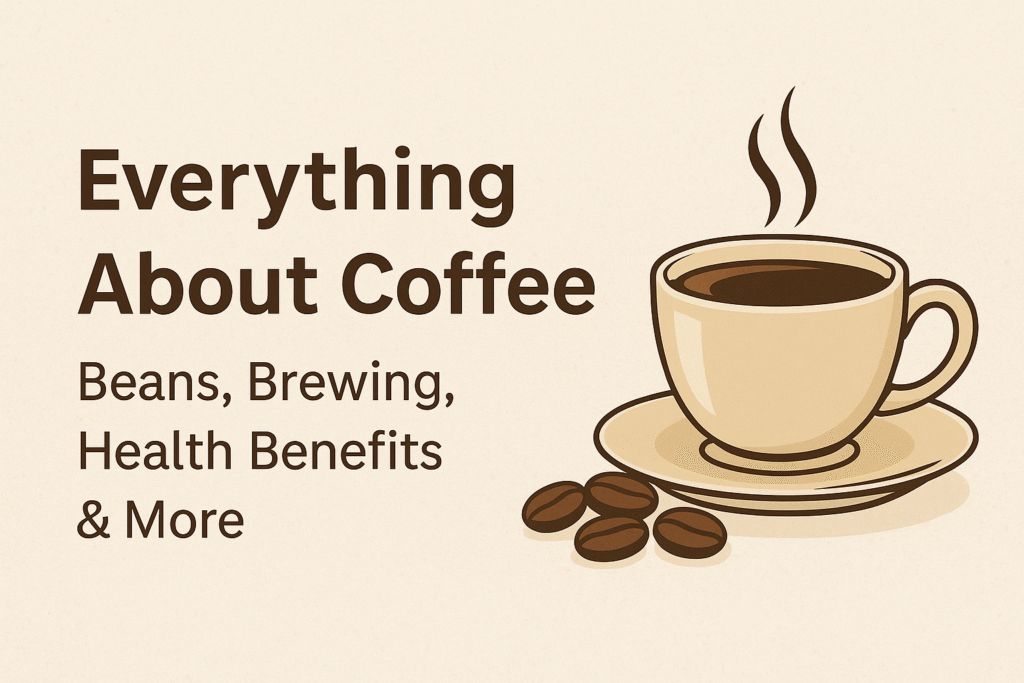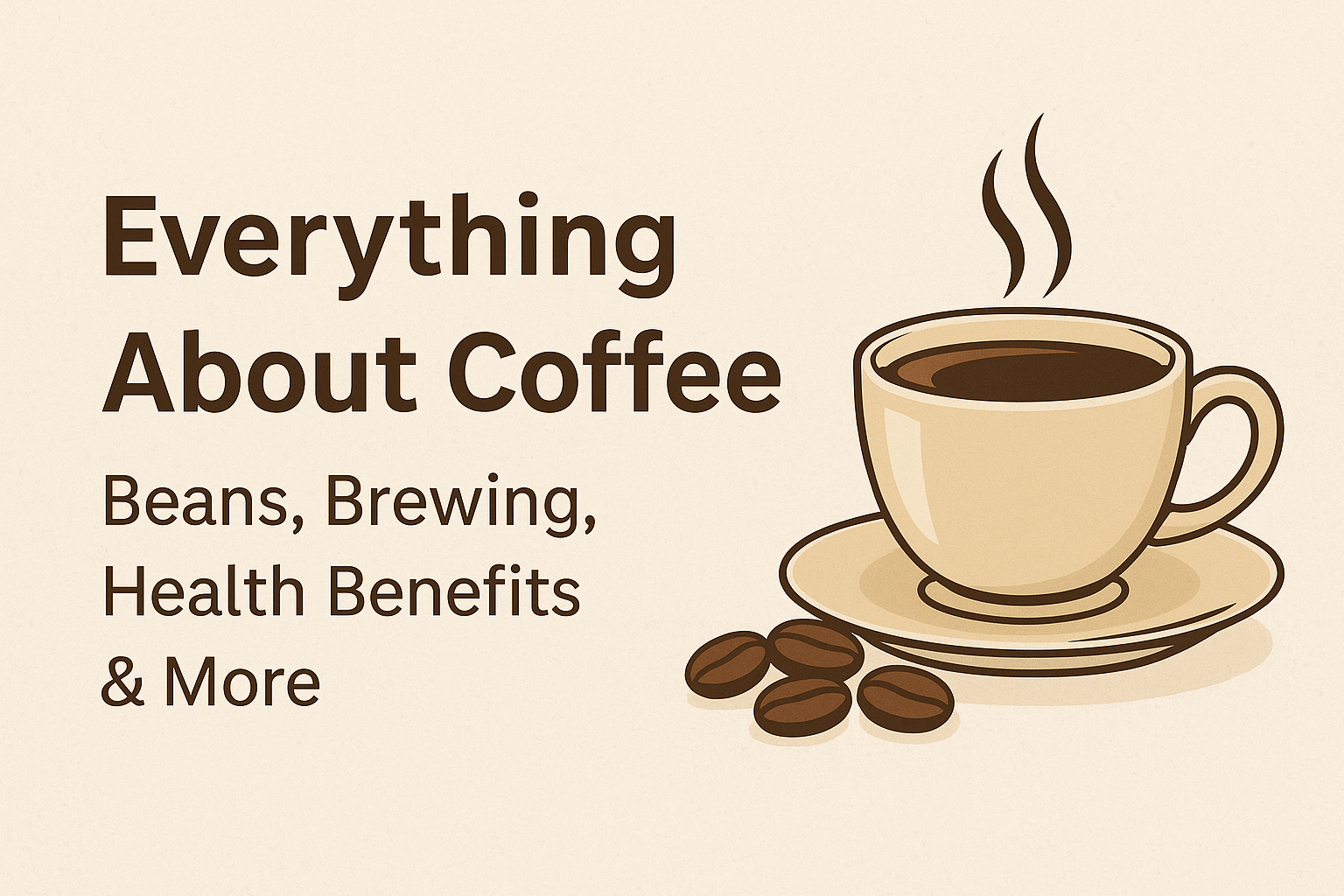Exploring the Origins of Coffee
Coffee holds a timeless appeal. It originated in the ancient highlands of Ethiopia, where stories suggest that a goat herder noticed increased energy in his animals after they chewed red berries. Intrigued by this discovery, local monks began using the berries to stay awake during long prayer sessions. As a result, coffee gradually spread throughout the Arabian Peninsula and into Europe. Over the centuries, it evolved into the global beverage we know today.
Different Types of Coffee Beans and Their Unique Qualities
Coffee beans aren’t all the same. They vary widely in flavor, aroma, and growing conditions. Understanding the four main types helps you choose the right cup for your taste.
1. Arabica Beans
Arabica beans dominate the global coffee market. These beans grow best at higher altitudes and in cooler climates. Unlike Robusta, Arabica delivers a delicate, slightly sweet flavor and has lower caffeine content. Consequently, they are preferred by specialty coffee lovers worldwide.
2. Robusta Beans
Robusta offers a bolder, more bitter taste. These beans grow in lower altitudes and require less care, making them more affordable. Furthermore, Robusta contains nearly double the caffeine of Arabica, providing a strong energy boost. Most espresso blends use Robusta for its thick crema and punchy taste.
3. Liberica Beans
Liberica, though less common, adds a smoky and woody profile to coffee blends. It thrives in specific climates, such as those in Southeast Asia and parts of Africa. Its distinct aroma and low acidity make it appealing to adventurous coffee drinkers.
4. Excelsa Beans
Excelsa, often considered a variety of Liberica, introduces fruity and tart flavors into coffee blends. While rare, Excelsa beans contribute depth and complexity, especially when blended with more mainstream varieties.
Most Popular Coffee Drinks and How They’re Made

With so many brewing methods and recipes, there’s a coffee drink for every preference. Below are some of the most popular options:
- Espresso: A rich, concentrated shot made by forcing hot water through finely ground coffee. It forms the base for many other drinks.
- Americano: Created by adding hot water to an espresso shot, it results in a milder taste.
- Latte: Combines espresso with steamed milk and a thin layer of foam, offering a creamy texture.
- Cappuccino: Blends equal parts espresso, steamed milk, and foam for a balanced, frothy drink.
- Flat White: Similar to a latte but with less foam and a more intense coffee flavor.
- Cold Brew: Steeped in cold water for up to 24 hours, this coffee is smooth and naturally sweet.
- Mocha: A delightful fusion of espresso, steamed milk, and chocolate syrup.
Health Benefits of Drinking Coffee
Beyond taste and aroma, coffee offers several health benefits. When consumed moderately, it can be part of a healthy lifestyle.
- Packed with Antioxidants: Coffee contains more antioxidants than many fruits and vegetables. These compounds fight inflammation and promote cellular health.
- Enhances Brain Function: Caffeine stimulates the central nervous system, improving concentration and mood.
- Boosts Physical Performance: Before a workout, caffeine increases adrenaline levels and prepares the body for exertion.
- Supports Liver Health: Research shows regular coffee drinkers have a lower risk of liver diseases like cirrhosis.
- Reduces Risk of Disease: According to several studies, coffee consumption is linked with lower rates of Parkinson’s, Alzheimer’s, and Type 2 diabetes.
Top Brewing Methods and Their Distinct Flavors
Brewing coffee is a personal art. While taste preferences vary, each method extracts flavors differently, allowing you to tailor your coffee experience.
1. French Press
This immersion method uses coarse grounds and hot water. After steeping for several minutes, a plunger filters the coffee. As a result, you get a full-bodied and bold flavor.
2. Pour-Over (V60 or Chemex)
Hot water is poured slowly over medium-coarse grounds in a filter. This method enhances delicate flavors and produces a clean, smooth cup.
3. Espresso Machine
Using pressure, this device pushes hot water through fine grounds. It creates a dense, flavorful shot that forms the base for lattes, cappuccinos, and more.
4. AeroPress
This portable brewer combines pressure and steeping, delivering a cup with low acidity and a rich mouthfeel in under two minutes.
5. Cold Brew
Here, coffee grounds are soaked in cold water for 12–24 hours. Because of the slow extraction, cold brew offers a naturally sweet and mellow flavor.
Best Practices for Storing Coffee
To preserve your coffee’s freshness and taste, proper storage is crucial. Here’s what we recommend:
- Use Airtight Containers: Oxygen degrades flavor quickly. Opt for opaque, sealed containers.
- Avoid Refrigerators: Moisture and odors can ruin the beans. Instead, store them in a cool, dry place.
- Buy Whole Beans: Grinding only what you need ensures maximum flavor.
- Consume Promptly: For the best taste, use coffee within two weeks of roasting.
How to Support Ethical and Sustainable Coffee
As coffee lovers, we also hold the power to make ethical choices. Supporting sustainable practices can have a positive impact on both people and the planet.
- Choose Fair Trade: This ensures farmers are paid fairly and work under ethical conditions.
- Go Organic: Organic farming avoids harmful chemicals, protecting ecosystems and your health.
- Support Direct Trade: This model fosters transparency and builds lasting relationships with growers.
- Use Eco-Friendly Products: Reusable mugs, filters, and compostable packaging reduce environmental waste.
Surprising Facts About Coffee
- Coffee ranks as the second most traded commodity in the world, after crude oil.
- Finland consumes the highest amount of coffee per person annually.
- The word “coffee” stems from the Arabic term qahwa, originally meaning wine.
- Beethoven was known to count exactly 60 beans per cup when brewing his coffee.
- Coffee grounds can double as fertilizer or be used in skincare routines.
Final Thoughts: Coffee is a Daily Ritual Worth Mastering
Coffee is more than a drink—it’s a ritual, an art, and for many, a daily essential. From understanding the origins of your beans to exploring brewing methods, every step enhances the experience. Whether you’re seeking a caffeine kick or a relaxing moment, coffee delivers both energy and enjoyment.
By choosing high-quality beans, ethical sources, and proper brewing methods, you can elevate your daily cup into something truly extraordinary.











